
|
Astronomy Picture Of the Day (APOD)
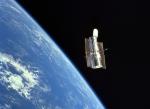 The Orbiting Hubble Space Telescope
The Orbiting Hubble Space Telescope
6.08.2001
The Hubble Space Telescope (HST) is the largest orbiting public optical telescope in history. Its 2.4 meter diameter reflecting mirror and its perch above Earth's atmosphere allow it to create exceptionally sharp images.
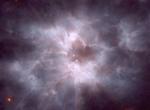 NGC 2440: Cocoon of a New White Dwarf
NGC 2440: Cocoon of a New White Dwarf
5.08.2001
Like a butterfly, a white dwarf star begins its life by casting off a cocoon that enclosed its former self. In this analogy, however, the Sun would be a caterpillar and the ejected shell of gas would become the prettiest of all!
 Neighboring Galaxy: The Large Magellanic Cloud
Neighboring Galaxy: The Large Magellanic Cloud
4.08.2001
The brightest galaxy visible from our own Milky Way Galaxy is the Large Magellanic Cloud (LMC). Visible predominantly from Earth's Southern Hemisphere, the LMC is the second closest galaxy, neighbor to the Small Magellanic Cloud, and one of eleven known dwarf galaxies that orbit our Milky Way Galaxy.
 Warped Spiral Galaxy ESO 510 13
Warped Spiral Galaxy ESO 510 13
3.08.2001
How did spiral galaxy ESO 510-13 get bent out of shape? The disks of many spirals are thin and flat, but not solid. Spiral disks are loose conglomerations of billions of stars and diffuse gas all gravitationally orbiting a galaxy center.
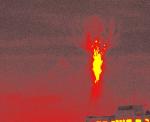 Burning Tree Sprite
Burning Tree Sprite
2.08.2001
This dramatic, garishly colored image was captured with a low-light level camera on 2001 June 7. It shows what appears to be a "burning tree" above the National Cheng Kung University campus in Tainan City, Taiwan ... but the burning tree is actually a fleeting red sprite 300 kilometers away.
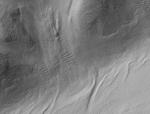 Young Martian Terrain
Young Martian Terrain
1.08.2001
What caused the pits, ridges, and gullies on otherwise smooth Martian terrain? One hypothesis is water. The lack of craters at this mid-latitude location indicates that the terrain is quite young by geological standards, perhaps only 100,000 years old.
 Oceans Under Jupiters Callisto
Oceans Under Jupiters Callisto
31.07.2001
Why does Jupiter's moon Callisto alter the magnetic field of Jupiter in its vicinity? Callisto itself does not have a strong magnetic field. One possible answer is that Callisto harbors sub-surface oceans of electrically conducting salt-water. This hypothesis was bolstered recently by a new analysis of how Callisto creates and dissipates heat.
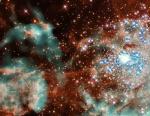 Star Cluster R136 Bursts Out
Star Cluster R136 Bursts Out
30.07.2001
In the center of star-forming region 30 Doradus lies a huge cluster of the largest, hottest, most massive stars known. Known as R136, the cluster's energetic stars are breaking out of the cocoon of gas and dust from which they formed.
 M57: The Ring Nebula
M57: The Ring Nebula
29.07.2001
Except for the rings of Saturn, the Ring Nebula (M57) is probably the most famous celestial band. This planetary nebula's simple, graceful appearance is thought to be due to perspective -- our view from planet Earth looking straight into what is actually a barrel-shaped cloud of gas shrugged off by a dying central star.
 A Daytime Fireball in 1944
A Daytime Fireball in 1944
28.07.2001
While stationed in central Africa in December 1944, Norman Appleton witnessed a meteor so bright he remembered it his entire life. Right before his eyes a tremendous smoking fireball streaked across the daytime sky. Years later, as an accomplished member of the Guild
|
January February March April May June July August September October November December |
|||||||||||||||||||||||||||||||||||||||||||||||||